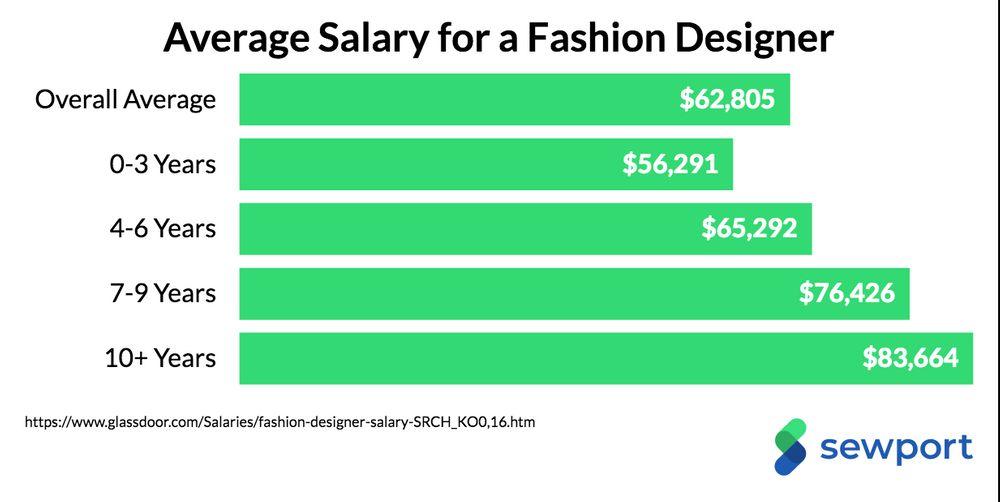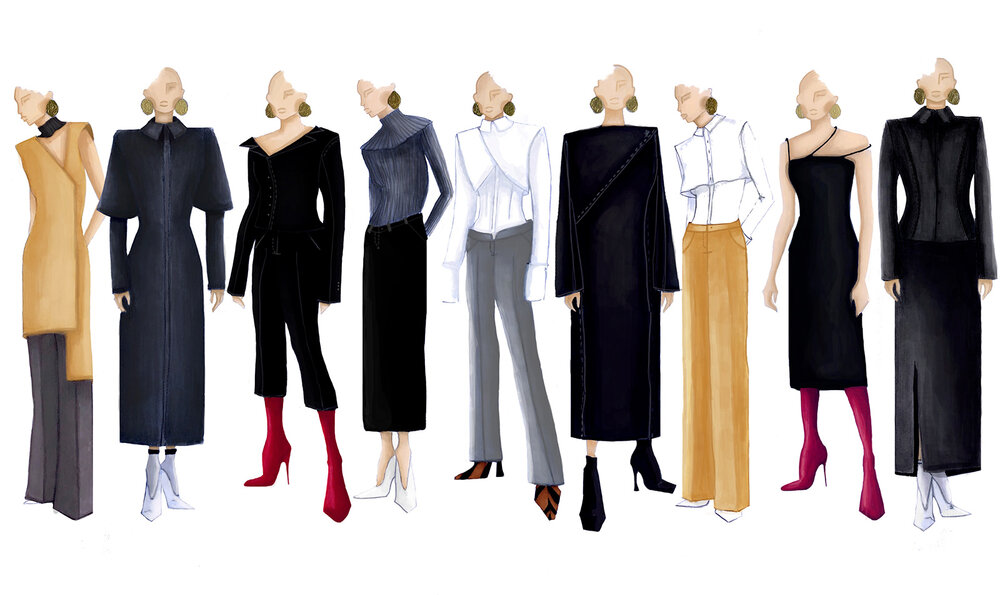I’ve spent years working with design teams, negotiating offers, and freelancing across fashion hubs, so I understand how much does a fashion designer make from both the creative and business sides. If you’re looking for a clear, modern answer: in the United States, a typical full-time fashion designer earns around the high $70,000s annually, with wide variation based on location, specialization, and experience. Freelancers often bill $50 to $150 per hour or a daily rate from $300 to $1,200, depending on scope and reputation. In this guide, I’ll break down real numbers, what drives them, and how you can move into higher-paying tiers with practical, proven steps.

Source: sewport.com
What Is The Average Fashion Designer Salary?
When people ask how much does a fashion designer make, I start with national data and then layer on real-world context. Recent federal labor data places the median annual pay for fashion designers in the upper $70,000s. That means half of professionals earn below that number and half above it. Entry-level roles often start in the $45,000 to $60,000 range, while experienced designers commonly land between $85,000 and $120,000. At the top end, design managers, senior designers, and creative directors can reach $140,000 to $200,000+, particularly in luxury, high-growth direct-to-consumer brands, and tech-adjacent apparel companies.
Market realities to remember:
- Demand is cyclical. Hiring spikes around brand expansions, new category launches, or seasons, and slows during retail downturns.
- Category matters. Technical outerwear, denim, performance wear, and accessories can command higher pay than basic cut-and-sew categories.
- Brand stage shifts pay mix. Startups may offer lower base pay with equity or bonus potential; global brands pay steadier salaries with structured bonuses.
I’ve personally seen mid-market brands pay slightly below headline averages but make up the gap through consistent annual raises and predictable bonuses, which can feel more secure than chasing a higher but volatile base elsewhere.

Source: www.hongkongda.com
Salary By Experience Level
Experience is the single strongest predictor of how much a fashion designer makes. Here’s a practical, experience-based view I use when coaching junior and mid-level talent:
- Intern and apprentice. Often unpaid or minimum wage, but the goal is portfolio depth, technical proficiency, and connections. A paid internship can range from $15 to $25 per hour in large markets.
- Assistant designer. Typically $45,000 to $60,000. Expect hands-on work like CADs, tech packs, trim boards, and line sheets. Strong Excel and PLM skills speed up promotions.
- Associate or mid-level designer. Usually $60,000 to $85,000. Own a category, liaise with vendors, and contribute to costing decisions.
- Senior designer. Commonly $85,000 to $120,000. Drive the vision for categories, mentor juniors, and present to executives and buyers.
- Design manager or lead. Often $110,000 to $150,000. Own cross-category direction, calendars, and cross-functional decision-making.
- Creative director or head of design. Frequently $150,000 to $250,000+, with bonuses tied to sell-through, margin, and brand growth.
Personal note: I once accepted a slightly lower base to lead a new capsule line with P&L exposure. That single move accelerated my next jump by two titles and a 25 percent pay bump because I could show measurable commercial outcomes, not just aesthetic wins.

Source: sewport.com
Pay By Location And Industry
Fashion is intensely regional. The same title can pay very differently by city and industry:
- New York City. Often the benchmark for US salaries. Higher base pay but also higher living costs. Many roles fall 5 to 15 percent above national averages.
- Los Angeles. Strong for denim, celebrity brands, and swim. Pay is competitive, particularly for senior denim and graphics specialists.
- San Francisco Bay Area. Fewer traditional fashion houses; however, apparel roles at tech-enabled retailers and e-commerce companies can pay premium salaries and stock.
- Other hubs. Austin, Miami, Seattle, and Columbus offer growing opportunities with moderate pay and lower cost of living.
Industry segments:
- Luxury. Higher base and prestige, but long hours and competitive promotion cycles.
- Active and performance wear. Solid pay with steady demand; premium for technical fabric and fit expertise.
- Mass and big box. Predictable comp, strong benefits, and good training; base may be slightly below luxury but with regular bonuses.
- Direct-to-consumer and startups. Wide range. Potential for equity; risk-reward varies by funding stage.
Cost-of-living tip: A $90,000 salary in a secondary market can yield more take-home lifestyle than $110,000 in NYC once rent and taxes are factored in. I always run a cost-of-living comparison before negotiating.

Source: money.usnews.com
Freelance Fashion Designer Rates And Income
Freelancers often ask how much does a fashion designer make when billing independently. Rates vary widely by niche and deliverables:
Typical ranges I see and use:
- Hourly. $50 to $150 for general design, $80 to $200+ for specialized technical design, pattern corrections, or fit engineering.
- Day rate. $300 to $1,200 based on expertise and scope.
- Per project. $1,500 to $8,000 for a mini capsule, $10,000 to $40,000+ for full-season development including tech packs, vendor management, and fittings.
Income stability hinges on retainers and stacked projects. A retainer at $3,500 per month with two steady clients can out-earn many in-house roles. Remember to price for:
- Pre-production rounds and revisions
- Fit sessions and sample reviews
- Sourcing time and vendor management
- Rush fees and scope creep
Pro tip from experience: Always define deliverables, number of revisions, and timelines in the contract. A tight scope is the difference between $120 per hour and $40 per hour in disguised overtime.
:max_bytes(150000):strip_icc()/fashion-designer-526016v1sf-edit-39120137a4254a9e9bd49155d20499aa.jpg)
Source: www.liveabout.com
In-House Compensation: Beyond Base Pay
Base pay is only part of how much a fashion designer makes annually. Total compensation can include:
- Annual bonuses. Often 5 to 20 percent of base, tied to company performance, margin, and sell-through.
- Stock or equity. More common at DTC and tech-enabled brands; vesting schedules matter.
- Benefits. Health, 401(k) match, commuter benefits, employee discounts, and education stipends add material value.
- Overtime and comp days. Some companies pay OT for hourly design roles; salaried roles may not, but you can negotiate flex time.
One of my best offers included a mid-range base but a 12 percent target bonus and 401(k) match. The predictable bonus effectively lifted my comp by another title’s worth without changing my hours.

Source: www.ied.edu
How To Increase Your Earnings As A Designer
I’ve watched designers double their income in three to five years by focusing on commercially valuable skills. Here’s the playbook:
- Become a category expert. Denim, outerwear, intimates, and performance wear pay premiums due to complexity and fit sensitivity.
- Master tech packs and costing. Fluency in PLM, BOMs, and margin math puts you at the decision table.
- Own vendor relationships. If you can solve production issues with factories directly, you are indispensable.
- Build a measurable portfolio. Highlight styles with sales lift, reduced returns, improved margin, or speed-to-market wins.
- Negotiate with data. Bring market comps, cost-of-living data, and your quantifiable outcomes.
- Consider lateral moves. A switch from a heritage brand to a growth DTC can add 10 to 20 percent to base pay.
- Diversify income. Freelance on the side with non-compete safe clients, or build a micro-collection for wholesale or drops.
Mistake to avoid: Relying only on aesthetics. Beautiful sketches don’t get you a raise unless you can tie them to sell-through or margin.

Source: intihannahlee.wordpress.com
Real-World Scenarios And Take-Home Pay
Let’s translate salary bands into monthly realities. These ballpark numbers assume a single filer; actual taxes vary by state and deductions.
- Entry-level assistant designer at $55,000. Rough post-tax monthly take-home might be $3,200 to $3,600. Rent should ideally be under $1,600. Consider roommates in tier-one cities.
- Mid-level designer at $80,000. Post-tax monthly around $4,500 to $5,000. With a 10 percent bonus, annual take-home jumps meaningfully.
- Senior designer at $110,000. Post-tax monthly roughly $6,000 to $6,700. Add a 15 percent bonus and strong benefits, and total comp becomes very competitive.
- Freelancer billing $100 per hour. At 20 billable hours per week, you gross about $8,000 per month. Budget 25 to 35 percent for taxes, plus health insurance and tools.
From my own budgeting, I set aside 30 percent of every freelance invoice for taxes and 10 percent for slow months. That cushion kept me calm during seasonal dips.
Education, Skills, And Portfolio Impact
Education opens doors, but your portfolio and outcomes open wallets. What hiring managers and clients consistently pay more for:
- Tangible results. Show sell-through lift, margin gains, or reduced returns.
- Fit mastery. Demonstrated ability to nail fit across sizes, backed by fit comments and before/after photos.
- Technical fluency. CLO3D, Browzwear, Adobe CC, PLM systems, grading and pattern basics.
- Market awareness. Trend forecasting connected to target customer insights and price points.
- Process leadership. Calendar management, cross-functional alignment, and on-time, on-cost delivery.
Certificate programs and short courses in 3D design or technical design can move the needle quickly. I once coached an associate designer who took a 3D apparel course and landed a senior role within six months with a 22 percent raise by showcasing faster sample cycles.
Frequently Asked Questions Of How Much Does A Fashion Designer Make
What Is The Average Salary For A Fashion Designer In The US?
A typical full-time fashion designer earns in the high $70,000s annually, with common ranges from $60,000 to $120,000 based on experience, location, and category.
How Much Do Entry-Level Fashion Designers Make?
Entry-level roles usually start between $45,000 and $60,000. Big coastal markets may pay slightly higher, but living costs can offset the difference.
Do Freelance Fashion Designers Earn More Than In-House Designers?
They can. Strong freelancers with retainers and specialized skills often out-earn in-house peers. However, income can be variable and requires managing taxes, insurance, and client pipelines.
Which Cities Pay Fashion Designers The Most?
New York City and Los Angeles generally offer the highest salaries. San Francisco Bay Area roles at tech-enabled retailers can also pay well, often with equity.
What Skills Increase A Fashion Designer’s Salary Fastest?
Technical design, fit expertise, 3D tools, PLM fluency, and the ability to tie design decisions to sales and margin outcomes are the strongest accelerators.
Is A Degree Required To Earn Well In Fashion Design?
A degree helps with access and networking, but a results-focused portfolio, technical skills, and real-world outcomes are what drive higher pay over time.
How Do Bonuses And Benefits Affect Total Compensation?
Bonuses commonly range from 5 to 20 percent of base. Add health benefits, 401(k) match, and stock or equity, and total comp can significantly exceed base salary.
Wrap-Up And Next Steps
Here’s the bottom line on how much does a fashion designer make: most full-time designers earn around the high $70,000s in the US, with clear paths to six figures through specialization, strong portfolios, and roles that connect creative work to commercial impact. If you focus on technical mastery, measurable results, and smart negotiations, you can move up bands faster than you might expect.
Take the next step. Audit your portfolio for business outcomes, learn one high-value technical skill this month, and run cost-of-living comparisons before your next negotiation. If this guide helped, subscribe for more salary breakdowns and practical career playbooks, or drop a question in the comments so I can cover it next.
Watch This Video on how much does a fashion designer make






